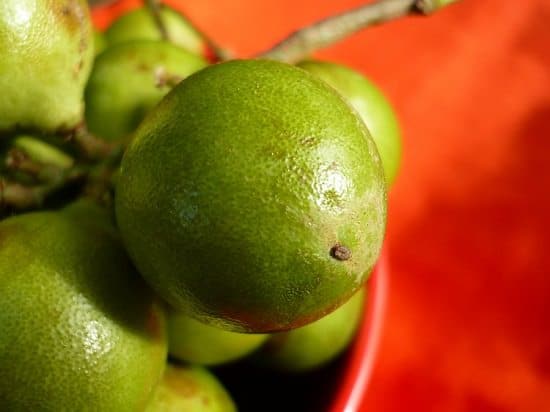Learn How to Grow Mamoncillo in this informative guide. Growing Mamoncillo is easy if you live in a warm climate and have a big garden or yard.
Mamoncillo is a fruit grows on an erect tall-growing mamoncillo tree. Growing mamoncillo in a small patio or garden is not possible. You’ll need a lot of space to grow this fruit tree.
Family: Sapindaceae
Genus: Melicoccus
USDA Hardiness Zones: 10, 11
Propagation Method: Cuttings, seed
Difficulty: Moderate
Other Names: Melicoccus bijugatus, Chenette, Quenette, Gnep, Guinep, Guaya, Guenepa, Kenip, Genip, Ginnip, Kenepa, Knippa, Spanish lime, Limoncillo
About Mamoncillo
Also, known as Spanish lime, mamoncillo resembles small lime sold in clusters, it doesn’t belong to the citrus family and is more like indehiscent fruit (fruit that has a hard outer shell and tough to open). It tastes between lychee to lime. It grows up to 25 meters (85 feet) tall and spread vigorously.
The fruit looks like small unripe mango, and it resembles the texture of a boiled egg: hard covering from outside and soft pulpy fruit inside and seed in the center. The pulp of the fruit is used in making pies, jelly, and delicious jams.
Growing Conditions
Mamoncillo grows in a subtropical and tropical climate. It is drought tolerant and severe damage inflict if exposed to frost. It can’t bear the temperature below 25 F (-4 C).
Also Read: How To Grow a Cashew Tree
Requirements for Growing Mamoncillo
Sun
Mamoncillo is a tropical tree, and like other tropical plants and trees, it loves full sun, heat, and warm exposure.
Soil
It can be grown in a variety of soil types, poor to rich and sandy but the soil must not be with very poor drainage.
Water
Established mamoncillo trees are drought-tolerant, though young plants (less than four years) require regular watering while establishing.
Mamoncillo Propagation
Instead of growing it from seeds, you should buy a plant from the nursery because mamoncillo grown from seeds takes 8-10 years to fruit and even that only after grafting. Buy a healthy plant and plant it on a dry, sunny spot of your yard, which is clear from other trees.
Mamoncillo Care
Fertilizer
Feed young mamoncillo plant (below four years) with a complete fertilizer every other month. Twice in a year apply well-rotted manure around it. Once the mamoncillo tree becomes mature and starts fruit production, apply phosphorous and potassium-rich fertilizer.
Pruning
Pruning is required to control the height as it can grow really tall. Also, to keep the shape, density and to maintain the structure of the tree.
Harvesting
After 4-5 years of growing, mamoncillo starts to fruit in the summer and early fall. If you grow it from seeds, it takes a long time up to 8 years to fruit. When fruit’s shell becomes brittle and easily breakable, then it is the time to harvest fruits.
Pests and Diseases
Keep an eye on fruit flies, citrus black fly, and several other common garden pests. Leaf spot and green scurf are the common diseases that might affect it.
Benefits of Mamoncillo Nuts
Packed with nutrients Mamoncillo offers various health benefits. They are the following:
- The fruit contains fibers that are helpful in reducing cholesterol and improves digestion.
- The Vitamin A present in mamoncillo is effective in improving immunity and preventing kidney stones.
- It also helps in lowering the blood pressure and useful for people who are trying to lose weight
- Its seeds when combined with honey is useful in treating diarrhea






I am looking for a grafted male/female Limoncillo tree. I live in Hawaii. Do you know how/where I can get a tree?
Aloha! I just found this feed and would like to know if you ever got the seeds of the guienup tree? Or Spanish lime tree? I live on the island of Oahu and it is one of my favorite tasting fruits! I also would like to get some seeds or a plant and grow it. Your feed was feom 5 years ago SO if you managed to get one im HOPING you have some fruit!!!!!! Let me know and we can become SPANISH LIME FRIENDS!!!! ALOHA!!!
Frankies on Oahu Waimanalo
Hi, I have started to grow one from a seed. It’s been almost a year now and it is growing but still pretty slow. I live in Tampa, Florida and I really enjoy this fruit. I still have some seeds from last year. If you like I can send to you, but I would need to know where to send them.
Mamoncillo is dioceous. Seedlings may be either male female or hermophrodite. So better buy a gfrafted nursery plant .
We are growing 8 of then indoor from seeds from Puerto Rico and VI (before Maria in 2017). We have fruit flies to fight and some leaves have brown spots. I am concern that some leaves are drying out and falling. My hope is to grow them and donate to a local garden with a tropical room. Any advice will be most appreciated. I have placed fly traps around the trees but I am sure if I am over-watering.
A long way, you can finish step by step, and then you can’t reach without a foot
I have several small plants from seed and also one tree from seed in my yard. It gets sparse blossoms now, but no fruit. It has a beautiful canopy and never any bugs around or under it. I want to grow the others to this size (took at least 10-12 years) because it’s so beautiful. The limbs are all gently rounded. I hope one day I have enough of them that they will be the right gender or hermaphrodite to create fruit! Any tips are welcomed.
Hello! My plant has brown spots coming up on the leaves. What do I do?!